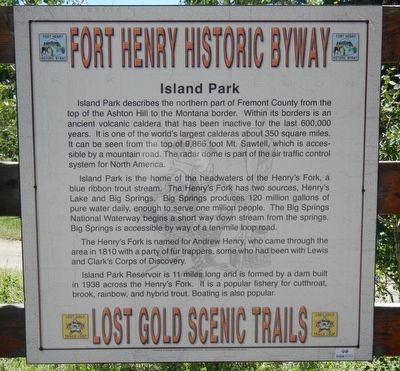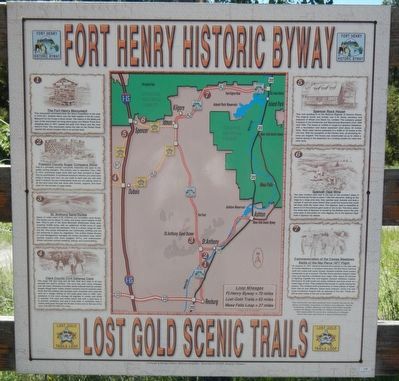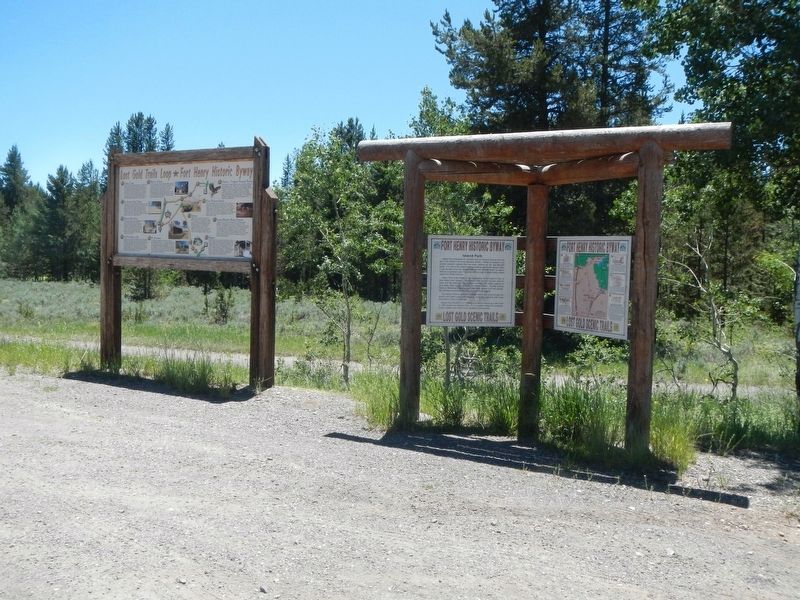Near Island Park in Fremont County, Idaho — The American West (Mountains)
Island Park
Fort Henry Historic Byway
— Lost Gold Scenic Trails —
Island Park describes the northern part of Fremont County from the top of the Ashton Hill to the Montana border. Within its borders is an ancient volcanic caldera that has been inactive for the last 600,000 years. It is one of the world's largest calderas about 350 square miles. It can be seen from the top of 9,866 foot Mt. Sawtell, which is accessible by a mountain road. The radar dome is part of the air traffic control system of North America.
Island Park is the home of the headwaters of the Henry's Fork, a blue ribbon trout stream. The Henry's Fork has two sources, Henry's Lake and Big Springs. Big Springs produces 120 million gallons of pure water daily, enough to serve one million people. The Big Springs National Waterway begins a short way down stream from the springs. Big Springs is accessible by way of a ten-mile loop road.
The Henry's Fork is named for Andrew Henry, who came through the area in 1810 with a party of fur trappers, some who had been with Lewis and Clark's Corps of Discovery.
Island Park Reservoir is 11 miles long and is formed by a dam built in 1938 across Henry's Fork. It is a popular fishery for cutthroat, brook, rainbow, and hybrid trout. Boating is also popular.
Second panel:
❶
This monument commemorates the Henry Expedition to the area in 1810-1811. Andrew Henry was the field captain of the St. Louis Missouri Fur Co. It was a harsh winter. The cabins in the fields just east of the monument are long since gone, but Wilson Price Hunt stopping here in 1811 named the post Fort Henry and the river Henry's Fork. The monument marks the site on the Parker Road nearest the actual location that is on private land.
❷
This is a privately owned, non-profit, historical site open to the public during daylight. This factory was in operation from 1904 to 1914, extracting sugar juice that was pumped to Sugar City for purification. A numbered brochure informs you what each thing is along the tour. As you walk to each site you will walk back in history. As you contemplate what your are seeing, think of all the hard work that was done with horses, wagons, and hand labor for the harvest of sugar beets.
❸
About 12 miles west of St. Anthony are incredible sand dunes. The dunes run for about 15 miles, and some reach heights of 500 feet. They're part of the Sand Mountain Wilderness study area, covering 10,000 acres, with an additional 10,000 acres of sage and juniper around
the perimeter. This is a winter range for deer and elk. The dunes themselves are continually shifting and are not anchored in place by vegetation. The United States Bureau of Land Management manages the dunes recreation area, which tourists explore with dune buggies, ATV's, and motorcycles. Winter activities include sledding, tubing, and snowmobiling.
❹
This large 700 feet long and 60 feet wide lava tube is 35 feet beneath the earth's surface. The cave has seen many changes over the years. Remains of buffalo skulls indicate that the animal sought refuge there. Indian artifact remains around campfire sites show that the Indians and perhaps even mountain men used the cave for refuge. Dating on the walls goes back to 1904. Temperatures in the cave average 40 degrees in winter and 55-60 in summer. The west and cinderblock wall with a steel door is to prevent vandalism and seal it from bats. The ventilation hole 5 inches wide goes through the 26 feet of lava rock to the top of the cave. Call 208 374-5397 for a tour.
❺
This rock building is on the National Register of Historic Places. The original owner and builder was C.W. Hardy, secretary and treasurer of Wood Live Stock Co. Limited. The company grazed livestock in the Centennial and Beaverhead Mountains from 1895 until 1934. The house is crafted of rough-cut igneous fieldstone, with a foundation wall below basement level about 42 inches thick. Rock walls narrow gradually to a width of 18 inches at the roof line. With the exception of the kitchen sink, all plumbing fixtures are original. The house was constructed so as to utilize a natural spring in the basement as a cooling system for meat and other food.
❻
Two deer hunters were lost in the fog on the southern slope of the Continental Divide at about 7,000 feet elevation. Sitting on the ridge by a large pine tree, they spotted opal nodules and took a sample. It was two years before they could find anyone that could tell them what the rocks were. The Spencer opal is classified at about 5.5 in the precious gem scale of one to ten. The mine, about five miles east of Spencer is owned by the Settlers and is the only mine open to the public for rock digging. Go to the Spencer Opal Café in Spencer for details.
❼
On August 19, 1877, General Howard bivouacked on the east side of Camas Meadows. In predawn darkness, the Nez Perce warriors stole the mules and some horses. Howard ordered three cavalry companies to go in pursuit. The Nez Perce warrior halted 8 miles away just beyond a timbered lava ridge. After about 20 minutes of fighting, Captain Carr and Captain Jackson withdrew. Captain Norwood's 35 men could not safely withdraw and took cover of a small ridge of lava. They sheltered the horses in a gully among the aspens. The soldiers built breastworks of loose pieces of basalt. Each rifle pit was different. Some were crescent, some oval and some horseshoe shaped with an opening at the rear. These can still be seen today at the site of the battle.
Topics. This historical marker is listed in these topic lists: Industry & Commerce • Natural Resources • War, Cold • Wars, US Indian. A significant historical date for this entry is August 19, 1877.
Location. 44° 27.234′ N, 111° 21.816′ W. Marker is near Island Park, Idaho, in Fremont County. Marker is on Kilgore-Yale Road near U.S. 20, on the left when traveling west. Touch for map. Marker is in this post office area: Island Park ID 83429, United States of America. Touch for directions.
Other nearby markers. At least 4 other markers are within 13 miles of this marker, measured as the crow flies. Pierre J. DeSmet (approx. 5.6 miles away); Harriman Wildlife Refuge (approx. 7.3 miles away); Harriman State Park (approx. 11 miles away); Caldera Lookout (approx. 12.7 miles away).
More about this marker. The marker is next to the entrance to the Island Park Landfill.
Also see . . . Battle of Camas Creek - Wikipedia. The exceptional precautions Howard had taken for the protection of Camp Callaway were observed by Nez Perce scouts. Upon returning to their own camp, they reported what they had seen to the chiefs. They decided to carry out a raid with the objective of putting Howard's cavalry on foot. The numbers of the raiders is disputed, although it was at least 28 and possibly many more. (Submitted on October 16, 2017, by Barry Swackhamer of Brentwood, California.)
Credits. This page was last revised on October 23, 2017. It was originally submitted on October 16, 2017, by Barry Swackhamer of Brentwood, California. This page has been viewed 544 times since then and 59 times this year. Photos: 1, 2, 3. submitted on October 16, 2017, by Barry Swackhamer of Brentwood, California.


